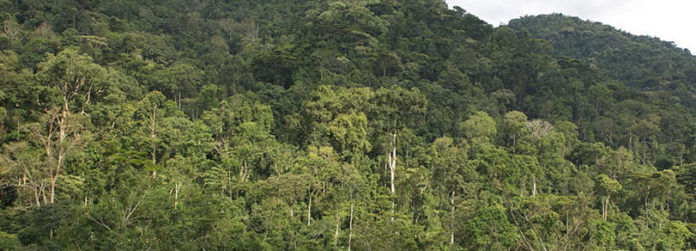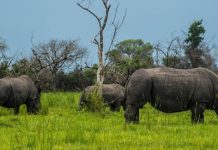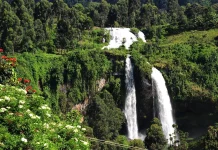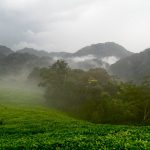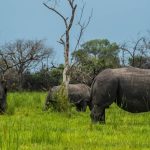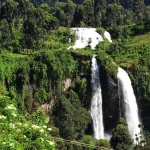Penetrating into the Bwindi impenetrable forest national park is a life changing experience you should not miss while on your Uganda wildlife safari. Well-known for being a home for the amazing endangered mountain gorillas, Bwindi Impenetrable Forest Reserve was set up in 1942 and afterwards elevated to Bwindi Impenetrable National Park in 1992. Found in southwestern Uganda, Bwindi Impenetrable National Park is part of the Bwindi Impenetrable Forest placed along the Democratic Republic of Congo border next to the Virunga National Park on the edge of the western Great Rift Valley. It consists of 331 square kilometres of tropical forest with both montane and lowland forest and is accessible barely on foot. The Bwindi Impenetrable National Park is a UNESCO-designated World Heritage Site with one of the richest ecosystems in Africa and a diversity of animal and bird species. The park is a habitat for some 120 species of mammals including 7 diurnal primates and about 30 elephants, 346 species of birds, 202 species of butterflies, 163 species of trees, 100 species of ferns, 27 species of frogs, chameleons, geckos and many endangered species.

being a shelter for the highest number of the world’s mountain gorillas, Bwindi impenetrable forest national park is a best place for gorilla safaris in Africa. There are 12 habituated Mountain Gorilla groups open to tourism split in the four sectors of Buhoma, Ruhija, Nkuringo and Rushaga in all corners of the park. The biologically diverse park derives its names from the local language ‘Bwindi’ (dark place) which defines the impenetrable nature of its thick forests.
In 1994, it was acknowledged as the world Heritage site. The word Bwindi means Impenetrable and what makes Bwindi Impenetrable is the fact that it has twisted vegetation wrapped over an intensively fissured backdrop of the sheer, draughty ridges as well as the slippery valleys and hills. The park has a big population of gorillas and is renowned for its coldness in the morning and at night. The coolest months are usually June and July and the average temperature is about 70c-200c. This is the reason why for safari purposes, one should come with warm clothes because Bwindi is so cold and receives about 2390mm of rain. It has two rain seasons, little rains are in the months of March-May and heavy rains are in the months of September as well as November and the rain in Bwindi forest lasts for longer hours.
Hot to get to Bwindi Forest National Park?
Bwindi National Park is found 520 Kilometres from Kampala, Uganda’s capital city. Usually stronger vehicles like 4Wheel Drives are recommended. There are two routes:
1. One can move from Kampala-Kabale (414Kilometres, between 5-7 hours), then Kabale-Kanungu- Kanyantorogo – Buhoma Park Headquarters, about 120kms, a 3.5hour-drive.
2. Kampala-Kabale (414Kms), then to Ruhija and finally to Buhoma which is 95 kilometres, a three-hour drive.
Bwindi Impenetrable Forest animal species:
- Gorillas, it’s an address for over 360 gorilla beringei, this is half the number of the remaining world mountain gorilla population.
- Chimpanzees
- Monkey i.e. Hoest’s, red-tailed and blue monkey, black and white colobus
- Olive baboon.
- Over 346 species of birds registered (Bwindi has 90% of all Albertine Rift endemics.
- Over 200 of butterflies.
- Mammals i.e. buffaloes, leopards, elephants and many more
Tourist Activities in Bwindi Impenetrable Forest National Park
Even though Bwindi Impenetrable Forest National Park is major known for harboring Mountain Gorillas, there are many other activities besides gorilla Trekking that any visitor could peacefully undertake and these include
1. Visiting Mountain Gorillas
Gorilla trekking is the core activity in Bwindi to the 4 Gorilla families of gorilla beringei. Bwindi National Park gorillas are organized now in four groups that can be visited by a tourist:
(a) Mubare group, this one has 16 gorillas and 1 silverback.
(b) Habinyanja group with 23 gorillas and 2 silverbacks.
(c) Rushegula group of 9 gorillas and 2 silverbacks.
(d) Nkuring group with 20 gorillas and 2 silverbacks.
The information concerning mountain gorillas can be got from Uganda Wildlife Authority (UWA) Headquarters or Bwindi Impenetrable National Park management or from a tour operator like AAB Tours and Travel. Bwindi Gorilla tracking is a bit tiresome, implying that bodily fitness is a very important aspect. By and large gorilla tracking runs from 8:30 am local Uganda time up to late hours of the day. About 8 permits are sold on a daily basis for each of these groups at UWA offices. So it’s better to book 130 days in advance to ensure proper programming. Visits to the gorillas are restricted for environmental and animal safety reasons and each gorilla group is only visited for one hour a day by a limited number of people who have normally purchased permits months in advance.
Gorilla Trekking Requirements
- It is worthwhile to come along with the following items for an efficient tracking of mountain gorillas in Uganda.
- Hiking boots- ankle level boots are ok but make sure it is something handy.
Rain Coat - Water proof container for their cameras
- A warm cardigan
- A pair of binoculars if you are a keen bird watcher.
- Video- filming is allowed in the parks though not outside the park
- Thick trousers and a long sleeved top are ideal for tracking.
- Gloves
- If you prefer wearing a hat, a baseball cap is recommended.
- Birding in Bwindi Impenetrable Forest
Bwindi Forest is a central point for birdwatchers. Hiking trails are open to people to view birds, butterflies, primates and trees along the Munyaga, Waterfall, Rushura, River Ivi, Mu bwindi swamp nature walks and Bamboo. Cultural walks can be undertaken to Buhoma village community for seeing traditional homestead, the healer, the banana brewing exercise, traditional handicraft and cultural concerts.
One can watch up to 150 bird species in a day especially at Buhoma and Ruhija. Identify your need to allow proper arrangements in time for the whole day. Bwindi has over 350 bird species, representing a 90% of all Albertine rift Endemics which include:
Short tailed Warbler
- White-tailed Blue Monarch
- Yellow-eyed black Fly-catcher
- Kivu Ground Thrush, Dusky Crimson Wing
- Bar-tailed Trogon
- Rusty-faced woodland Warbler
- Gruer’s Rush Warbler
- Wilcock & Honey-guide and many more
A good number of these birds are very uncommon in the Great Lakes Region and the prospects of seeing them in Bwindi forest are high.
Munyanga River Trail
Munyanga river trail is a moving small walk for visitors with restricted time. Interesting to see here are basically birds and primates at the forest fringe. The amazing waterfall trail provides an attractive feature of the forest with a large amount of tree ferns, epithetic ferns, orchids and Bwindi’s colourful collection of butterflies. This trail gives a clear image and a calm of a true tropical rain forest.
Nature Walks
Lasting between 2 to 4 days in the park, there are 4 exciting hiking trails. There is likelihood to see and gain knowledge about primates, different exceptional bird species, butterflies, trees, plants and other organisms on all the four trails. Under the direction of a skilled guide, who is a requirement on the tour, you get a wider knowledge of how the park’s coordination operates. The guides understand well the primatology, ornithology and botany of the park.
Ruizi River Trail
This is the longest of the trails and takes a full day to complete and it is always good for bird lovers. Visitors in 4WD vehicles transport should reflect on crossing the rough centre of the park through Ruhija. While on this Uganda trip, look out for duikers, primates and both forest and grassland bird species. In Ruhija, visitors can get the three-hour panorama crowded trek to the Mubwindi swamp. One can also stroll expediently to the Bamboo zone.
Rushura Trail
This trail is very pleasant for the reason that it commands an open view across the western rift valley floor. To the west, Congo’s Parc Nationale des Virungas provides an impressive backdrop of clear Lake Edward and the Rwenzori Mountain.
Muzabiro Trail
Muzabiro Trail presents relaxed incredible spectacular view of Bwindi Forest, Western Rift Valley and the Virungas. While on your way, you will view a lot of ancient tree ferns. When you get to the top of this trail, you will appreciate the fantastic spot for a picnic lunch.
Bamboo Trail – it is among the areas of the highest range in the park and its trail offers 14 vegetation types. When at the pinnacle of this trail, you are treated to an open picture of the comprehensible water Lake Bunyonyi and the thick Mafuga Forest.
Cultural Performances
In the evenings at Bwindi, there are by and large distinguished by conventional dance performances by local tropes mainly women and orphan groups and money from these performances is intended for improving the lives of the locals who live around the park. One is at liberty to participate in the dancing with the locals, a thrinlling experience indeed.
ACCOMMODATION
Bwindi is exceptional with numerous accommodation facilities of almost all classes of people. Accommodation below is of deluxe, midrange and budget nature:
- Mantana, with very luxurious safer tents
- Abercrombie and Kent with luxury secure tents.
- Ruhinja Guest House
- Buhoma Homestead
- Savannah Resort Hotel at Kihihi
- The local community also operates a clean accommodation camp with a restaurant serving traditional dishes for breakfast, lunch and super
- In Kihihi, Savanna Resort Hotel is 40 kilometres to Buhoma and near Ishasha sector, of Queen Elizabeth National Park
Gorilla Trekking Precautions
- When you come across the gorillas, make an effort to be obedient as much as possible.
- Try to give a sideway look; don’t look at them straight in the face.
- Stick tightly to the group
- Talk softly or in whispers
- They don’t like flash photography
- Gorillas are wild
Gorillas are a bit wild and should not be irritated carelessly. Uganda Wildlife Authority (UWA) has a warning notice that it does not take any responsibility for any injury sustained by wild animals in their habitats, therefore, always:
- Keep your distance of about 7 metres from the gorillas
- Do not give food to the gorillas
- Know that gorillas have a right of the way
- Do not persuade them to get into contact with you in any way
- Do not eat in the environs of the gorillas
Gorilla Health
Currently; there are just about 700 mountain gorillas in the world. Thus these animals are classified as endangered species.
To keep away from transmitting human diseases to them;
- Try to avoid tracking if you are suffering from transmittable diseases. In case you develop a severe case of flu, your money will be fully refunded if you make this known in advance. Do not sneeze towards them
- Do not spit out in the forest or defecate carelessly. If you have to, the guides will help you with a matchet to dig a hole to bury your waste.
- Any person under 15 years is not allowed to track gorillas.
